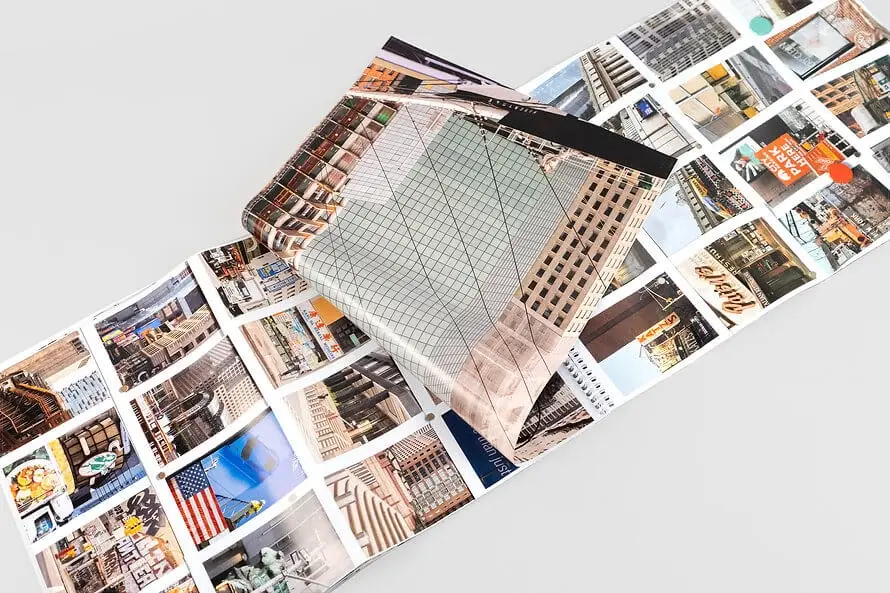Review of “Days Without Number, New York City,” photographs by Giovanna Silva, with a text by Sasha Frere-Jones
Review by Michael Quinn
You hardly know anyone, and there’s no place you need to be, so you walk around to get your bearings. You snap pictures of whatever catches your eye. You’re trying to capture a feeling—not just the place but the mood you’re in. Everything feels new, even familiar things you’ve seen back home. You listen to the same song on repeat. It reminds you of someone special, the reason you’re here. And now, it’s the first song on a new soundtrack: your relationship with New York City.
A Puzzle of Images
This past fall, I attended a talk at the Center for Architecture in Greenwich Village where Milan-based photographer Giovanna Silva discussed her new book, “Days Without Number, New York City.” With her short bleached blond hair and oversized blazer, she radiated a cool confidence.
Silva’s book is spiral bound like a calendar and features more than 700 photos of the city, captured over three years. Each page is filled with loose grids of white-bordered color photos—about 16 per spread. During her talk, Silva explained how she experimented with different compositions on the side of her fridge, using magnets to hold the photos in place. Some of those magnets even appear in the final layouts, which feel both studied and casual, as if the images could be reshuffled at any moment. Her American publisher, Fort Greene-based Head Hi, calls it “a puzzle of images.” It invites viewers to create their own meaning.
Time, Time, Time
In the introduction, musician and writer Frere-Jones offers his interpretation in a short, vivid essay that feels like a Super 8 film—fast-paced, jumpy, brimming with energy. He narrates a bike ride through the city, skidding and bumping along, calling New York “the old girl” and lamenting how her 400th birthday passed unnoticed. “The city is covered with clocks, if you have time to look for the time,” he writes. Time, and the changes it brings, dominate his reflections. He observes the rise of luxury towers, recharging stations and scaffolding. At one point, his internal monologue seems to address Silva directly: “You’re new. That’s okay. We are all new each day.”
The Eye of an Architect
Some images were shot with a professional camera, others on an iPhone. But what defines a photographer—the equipment or the eye?
Silva, trained as an architect, takes striking portraits of buildings stripped of people, their energy strong and masculine. Over time, though, other elements sneak into her frames: three Hasidic men crossing the Williamsburg Bridge, the bright green of leafy trees, a pair of seagulls—one facing away, the other mid-flight.
Her photos capture traces of the old city: neon signs, faded brick advertisements and water towers. Then there’s the blur of yellow taxis, a van with “God Is Amazing” written in bold letters (and, beneath it, “Great & Amazing…” as if the writer couldn’t contain their awe). We see an ad where a sultry Statue of Liberty bites a slice of pizza and Coney Island’s sun-bleached, trashy glamour. American flags, halal trucks, Chinese lanterns and rainbow flags all appear—reflecting the city’s layered history and the overlapping lives of its many communities.
Memory and Mood
Silva doesn’t organize the photos by neighborhood but by visual relationships—patterns, shapes, colors. Familiar landmarks reappear across multiple spreads: the Garment District’s giant button and sewing needle, the globe sculpture at Columbus Circle.
Some photos get full-page spreads: the opaque glass grid of a skyscraper rising behind an old ship docked at the South Street Seaport and the multicolored fire escapes on a row of red-brick tenements. Another page reveals a mass of beige buildings, crowding out the sky.
The lack of a strict structure mirrors our personal experiences of the city—a collection of impressions shaped by memory and mood. What do we notice, and what do we forget? For those who love walking through Manhattan, the book will evoke both recognition and the feeling of seeing something new.
A Love Story
At the launch, Silva shared that she came to New York because she’d fallen in love with a woman who lived here. The lyrics of the Sinéad O’Connor song that inspired the book’s title capture her intent perfectly: “I wanna make something beautiful for you, and from you, to show you, to show you I adore you.” When an audience member asked how the relationship had worked out, Silva blushed and admitted she was with someone new. But as “Days Without Number” shows, it’s the city that has truly claimed her heart.









